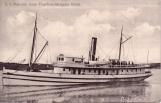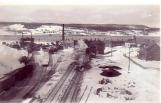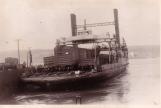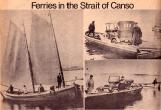15
WE TRAVELLED BY PASSENGER BOATS -Many made regular scheduled stops. In 1894, it was the S.S. Eldon that did the loop from Port Hawkesbury to Port Hastings to Mulgrave to Point Tupper. The Eldon left Point Tupper after the express train from Sydney had arrived. Other boats ran from Port Hawkesbury to Arichat and Sydney. The SS Cann made the Guysborough to Mulgrave trip.
There were cruise ships in the Strait of Canso during the summer and many travelled on the Boston Boats to visit or work in the New England States areas.
17
Many ships traveled back and forth from New England. The arrival of such vessels in Port Hawkesbury is discussed in "Port Hawkesbury, Nova Scotia - A Glimpse of the Past.""Everyone looked forward to the arrival of the ships from Boston - 'The Boston States', as it was often called. On the day of arrival scores of people went down to the docks to catch a glimpse of the latest fashions and to meet long lost relatives. Most of these relatives had left Cape Breton in their early teens to work as maids and carpenters' helpers, and returned - often sporting fancy clothes and a Boston accent - still homesick many years later."
19
SCOTIA ll TRAIN FERRY - Following the outbreak of World War I, the need for materials from the industries of eastern Cape Breton, especially the coal and steel, put a strain on the ferry system at the Strait of Canso. A new ferry, the Scotia II, was put into service in 1915. At over 300 feet long and a capacity of 18 45-foot rail cars - 6 each on 3 tracks - the Scotia II - operating with the first Scotia - helped ease the bottleneck of freight crossing the Strait of Canso. Like the Scotia, the Scotia II was a coal-powered ship.During WW II, there was a fear that German submarines might try to sink the train ferries to prevent the coal and steel supply reaching its destination.
21
POINT TUPPER RAIL YARD - Point Tupper began to grow and more men were needed to keep tracks clear and the trains going. Locomotives or engines were not transported across the Strait of Canso on the ferries. When a train arrived in Mulgrave or Point Tupper, whether passenger or freight, the locomotive would detach and the cars would enter a queue to cross the Strait. The process of loading was explained in Cape Breton's Magazine by Hiram Crittenden."Where the boat came to the wharf, there was an apron that would go up or down about 5 or 6 feet, to correspond with the tide and the boat. The apron had rails on it, and had to come right down aboard the boat - they'd couple it up with what they called latches. That would link the boat to the wharf, and the three sets of tracks on the Scotia would be linked up to the tracks in the railway yard... They'd make the trains right there, push them on and haul them off the boats with the yard engine. It took a lot of man power to keep these rails clear all winter".
22
Scotia Train Ferry Dock looking south east from Hadley's Hill area.1910
Mulgrave, Guysborough County, Nova Scotia, Canada

23
WORKING CONDITIONS ON THE SCOTIA - Sitting blind in the bowels of the ship, the work crews would encounter problems with little idea about what was happening on deck, or around the ship. Hiram Crittenden explained in an interview in the Cape Breton's Magazine."We'd get so far to the docks, we'd be almost ready to couple her up - and something would happen down below - shut everything off. Now that would be ice clogging the condenser. Normally the salt water came up through the bottom of the boat and into the condenser, and you, and you could see the stream of water flowing out again, out the side of the boat. And when the ice would clog the water it would kill the dynamo, lights went out and we'd have to shut our engines down".
25
FERRY RAILWAY TRAFFIC - According to a Department of Mines and Technical Surveys done in 1953, the volume of railway traffic transported by ferry boats had been 40,000 in 1920 and was up to 115,000 by 1946.The heavier traffic of commodities was always westward rather than eastward across the Strait to Mulgrave and the rest of Canada - coal and later steel from Industrial Cape Breton being the main products. The largest tonnage going east to Cape Breton was composed of general freight and food.
27
FERRYMEN EMBREE and WALKER - Captain James Embree of Port Hawkesbury is credited with being the first operator of a vehicle carrying ferry in the Strait of Canso in 1913. His father ran a private ferry before him. James' ferry was a flat bottomed scow pulled by a kind of sail boat or it was rowed.In 1922, Captian P.J. Walker was granted the monopoly on ferrying automobiles across the Strait of Canso. His ferry was built as a landing barge for WW I but he refurbished it to become the Edith C. Walker in 1925. In her last year of operation, 1925, the Edith C. Walker ferried a total of 2,904 automobiles.





